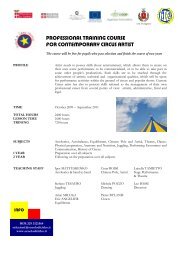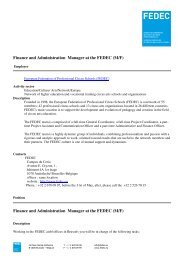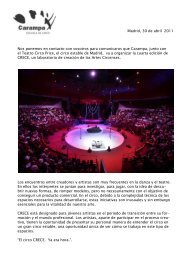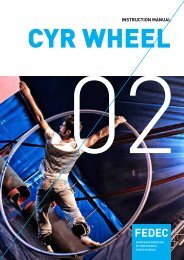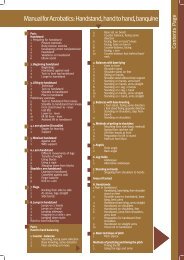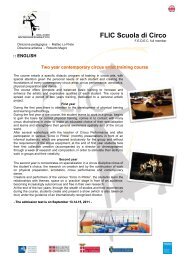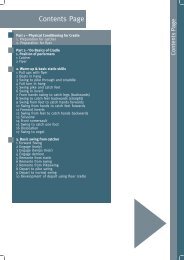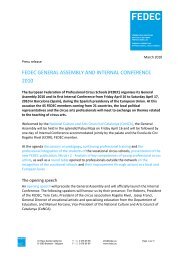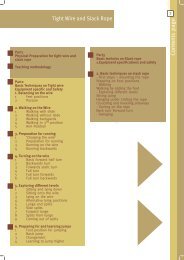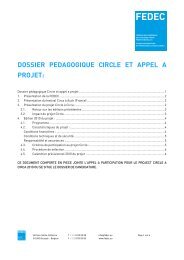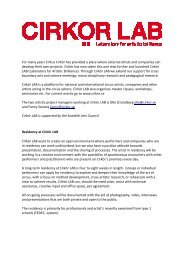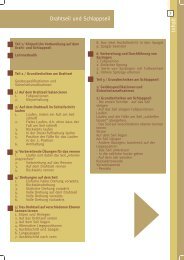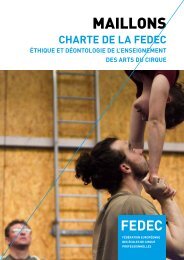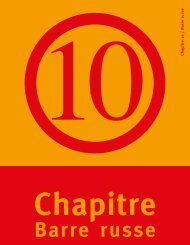Basic Circus Arts Instruction Manual - Fedec
Basic Circus Arts Instruction Manual - Fedec
Basic Circus Arts Instruction Manual - Fedec
You also want an ePaper? Increase the reach of your titles
YUMPU automatically turns print PDFs into web optimized ePapers that Google loves.
<strong>Basic</strong> <strong>Circus</strong> <strong>Arts</strong> <strong>Instruction</strong> <strong>Manual</strong><br />
Preface<br />
This circus arts manual is the result of a series of professional development modules organised<br />
by The European Federation of Professional <strong>Circus</strong> Schools (FEDEC) through the « European<br />
Network for Pedagogical Exchanges » (EPE) project.<br />
This EPE Network was comprised of six professional development modules, each specifically<br />
dedicated to the technical aspects of the circus disciplines contained in this manual, as well<br />
as a seventh « transversal » module related to « Safety and Rigging ».<br />
This project was a European first!<br />
These seven modules were held between November 2005 and April 2007, and each module<br />
attracted an average number of 22 teachers coming from all the major professional circus<br />
schools from Europe and around the world (Canada, Australia, Colombia…)<br />
What you are holding in your hand is the fruit of all the exchanges between all of these<br />
teachers, collated and edited by the Pedagogical Coordinator, Jeff Hewitt Davis.<br />
We propose that this collection be considered as basic reference material for circus arts<br />
teachers, and future circus arts teachers, and as complementary to their on-going practical<br />
education.<br />
The implementation of this network and the production of this manual were made possible<br />
thanks to the support of the European Community (Leonardo da Vinci – Education and<br />
Culture).<br />
This project has been funded with support from the European Commission. This publication reflects the views of the author<br />
only, and the Commission cannot be held responsible for any use which may be made of the information contained therein.
Partners of the project<br />
Other participants to the project<br />
Credits:<br />
Writing, drawings and photographs (unless contrary information)<br />
Jeff Hewitt Davis, helped by Glen Stewart<br />
Writing of chapter 8 - Thomas Loriaux<br />
Contributions<br />
Clare Anderson (chap. 2)<br />
Eric Angelier (chap. 3)<br />
Pascal Angelier (chap. 6)<br />
Fabrice Berthet (chap. 5&6)<br />
Zygmunt Biegaj (chap. 6)<br />
Yuri Bozyan (chap. 2&6)<br />
Pierre Carrier (chap. 2)<br />
Mat Daniels (chap. 5)<br />
Vicente Espinosa (chap. 6)<br />
Christian Etienne (chap. 4)<br />
Gérard Fasoli (chap. 7)<br />
Viktor Fomine (chap. 7)<br />
Lucy Francis-Litton (chap. 6)<br />
Lesley Gardener (chap. 6)<br />
Martin Gerbier (chap. 6)<br />
Sasja Gravilov (chap. 6)<br />
Jonathan Guichard (chap. 3)<br />
Juliette Hardy-Donaldson (chap.4)<br />
Roland Holzapfel (chap. 3)<br />
Sophie Kantorowitz (chap. 4)<br />
Bruno Krief (chap. 5)<br />
Vitold Kuvshynov (chap. 6)<br />
Pascale Loiseau (chap. 7)<br />
Christian Malgoires (chap. 6)<br />
Patrick Mattioni (chap. 5)<br />
Igor Matyushenko (chap. 6)<br />
Melissa Merran (chap. 2)<br />
Arian Miluka (chap. 3)<br />
Witek Nowotynski (chap. 6)<br />
Jonathan Priest (chap. 2)<br />
Vasily Protsenko (chap. 3)<br />
Viktor Renpening (chap. 6)<br />
Luc Richard (chap.2&7)<br />
André Saint-Jean (chap. 6)<br />
Yuri Sakalov (chap.4&7)<br />
Julien Scholl (chap. 5)<br />
Joël Suty (chap. 4&7)<br />
Johnny Torres (chap. 6)<br />
Marina Vavilova (chap. 6)<br />
Escuela National Circo para<br />
Todos<br />
Staatliche Ballettschule<br />
Berlin und Schule für Artistik<br />
Translation<br />
Chapter 8 translated from French by Apostrophe translation (Belgium)<br />
Rereading: Aldous Everard , Tim Roberts<br />
Design<br />
Jean-François Hocq<br />
Editorial management<br />
Banquine asbl (Lolita Bassambi, Raphaël Brigandi, Edwine Tita and Camille Vlérick)<br />
Thanks<br />
The Education Minister and the administration of the Commission Communautaire française<br />
(Belgium).<br />
Printed in September 2007 - © FEDEC - European Federation of Professional <strong>Circus</strong> Schools - 7 rue des Ecoliers - B-1160 Brussels (Belgium)
Steps for the production of the manual<br />
This manual is the result of the work done within the framework of the "European Network<br />
for Pedagogical Exchanges" (EPE network), a project initiated by the European Federation<br />
of Professional <strong>Circus</strong> Schools (FEDEC)<br />
The objectives of this network were:<br />
• to promote and share the teaching methods of each school;<br />
• to validate and spread the most effective methods used;<br />
• to raise the level of expertise of all the teachers from the schools of the Federation;<br />
• to stimulate the mobility of students and teachers;<br />
• to promote inter-cultural exchanges;<br />
• to create a durable network of teachers.<br />
1) Organisation of vocational training module<br />
Initially, the EPE network has allowed a maximum of teachers to meet in order to share<br />
their practical and theoretical knowledge, via seven modules of training and exchanges.<br />
These modules have been hosted by seven schools of the network: Die Etage (Berlin) the<br />
École Supérieure des <strong>Arts</strong> du Cirque (Brussels), the École Nationale des <strong>Arts</strong> du Cirque de<br />
Rosny-sous-Bois (Paris) the Escuela de Circo Carampa (Madrid), the Scuola di Formazione<br />
Arti Circensi Flic (Torino), the Centre National des <strong>Arts</strong> du Cirque (Châlons-en-Champagne)<br />
and The <strong>Circus</strong> Space (London).<br />
Each module took place during a period of six days, and alternated lectures and demonstrations<br />
by teachers, debates and discussions, practical workshops and open exchanges.<br />
The pedagogical coordinator, Jeff Davis, was responsible for the organisation of these<br />
working weeks. He was also in charge of collecting the information needed to produce<br />
pedagogical tools.<br />
A first evaluation was led by the pedagogical coordinator and the pedagogical director of<br />
the hosting school at the end of every module.<br />
More than 150 teachers and 120 students from all the major professional circus schools of<br />
Europe and around the world took part to these encounters, held between November 2005<br />
and April 2007.<br />
2) The production of pedagogical tools<br />
Afterwards, Jeff Davis summarised the results of these exchanges of knowledge in the form<br />
of the present handbook, composed of independent chapters.<br />
The aim was to put into writing the sum of oral knowledge available in our network, in<br />
order to preserve a record of the teachers' skills and to build a tool that could be used<br />
as a basis reference for each chosen technique.<br />
This work has been enriched by pedagogical films, edited in parallel on the on the basis<br />
of the pictures filmed during each module.
3) Evaluation of the pedagogical tools<br />
Every chapter of the handbook was examined by a representative sample of FEDEC<br />
teachers on the basis of an evaluation grid defined by the entire partnership. These<br />
teachers may, or may not have, taken part in the modules concerned.<br />
Thanks to these evaluations, Jeff Davis has been able to make the necessary corrections<br />
and to make the handbook more relevant.<br />
In May 2007, the final draft of the corrected handbook has been examined one last time<br />
and approved by all the partners of the project.<br />
4) Definition of a methodology for transmitting the knowledge<br />
In parallel with the production of the tools, the EPE network has continued to give<br />
thought to the collection and the transmission of circus skills and to the definition of<br />
an optimal model for organising a module for pedagogical exchanges.<br />
5) Diffusion of the results to the final users (circus arts teachers and future teachers)<br />
The <strong>Instruction</strong> <strong>Manual</strong> and the pedagogical films that accompany it will be distributed<br />
throughout the whole circus network (professionals and amateurs), via FEDEC members<br />
and the website.



